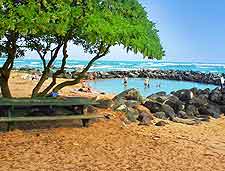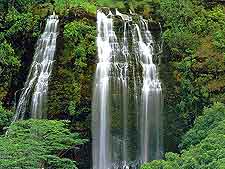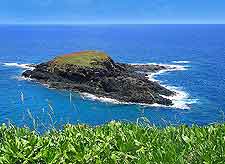Kauai History Facts and Timeline
(Kauai, Hawaii - HI, USA)

In ancient times, the island of Kauai was populated by migrants from the 2,000-mile / 3,220-km distant Polynesian archipelago of the Marquesas, who arrived in their double-hulled outrigger canoes crammed with pigs, chickens, dogs and all manner of crops including taro, coconuts, sugar cane and lots of ripening bananas.
Until then, this remote island was only home to 1,300 indigenous species of flora and just two native mammals, the monk seal and the hoary bat, although green turtles also visited. Excavated evidence of early Kauai history points to settlement as far back as 200 AD, with large communities established by 1300 AD.
From Sacred to Profane
For hundreds of years, the Wailua region of Kauai was considered sacred, with rulers from other islands in the archipelago arriving to birth their children in the traditional spiritual hub. Outside influence, however, was non-existent until, in 1778, English mariner Captain James Cook and his sailors made landfall from the ships Discovery and Resolution. Their arrival opened the floodgates for an influx of Europeans, with missionaries, laborers and businessmen all bringing diverse cultures and Western diseases that decimated the indigenous population, and the bloodstock of the native Hawaiians was diluted.
King Kaumuali'i
The island remained independent from contact with the rest of the archipelago until the last 20 years of the 18th century, which were to change the settled history of Kauai forever. The nation's greatest king, Kaumuali'i, was born in 1780 in sacred Wailua, and his wisdom saved his people from annihilation by King Kamehameha's forces during the unification of the islands. Kaumuali'i's bloodless surrender ensured his dynasty's survival as rulers until the island came under the control of
Honolulu, Hawaii's capital.

Missionary Influence on Kauai
Among the first non-natives to arrive on Kauai were American missionaries, establishing the missions first in Waimea and later in Kaloa, to the island's south, and Waioli, to the north. Vast changes in the lifestyles of the islanders resulted, with women forced to wear long, loose gowns and the traditional, sacred hula dances forbidden.
While deconstructing the native culture of the island, the missionaries created a written Hawaiian language, using it to produce bibles. As in the rest of the Hawaiian Islands, the children of the missionaries diversified into commerce and plantation owning, becoming powerful as a result and introducing waves of immigrant workers, diluting the local culture still more.
Multicultural Immigration
During the remainder of the 19th and into the early 20th century, immigrant Japanese, Koreans, Chinese, Puerto Ricans, Germans, Spanish, Filipinos, Portuguese and Norwegians first worked the sugar plantations under privation. Later they branched out into business and commerce, purchasing land and retaining their original cultures and languages, but eventually merging with the native Hawaiians to form a vibrant and proud multicultural part of Kauai's long history.

A New Start
The sugar and pineapple industries had been the economic mainstay of Kauai island for over 100 years before their decline in the early 20th century, with tourism replacing them in short order.
The beauty of the island and its multicultural mix were already attracting tourists before Hawaii became an American state in 1959, with new hotels springing up along the coastline. In spite of hits from severe hurricanes in 1959, 1982 and 1992, tourist numbers have continued to rise, with the tourism sector now Kauai's principal source of revenue.
 In ancient times, the island of Kauai was populated by migrants from the 2,000-mile / 3,220-km distant Polynesian archipelago of the Marquesas, who arrived in their double-hulled outrigger canoes crammed with pigs, chickens, dogs and all manner of crops including taro, coconuts, sugar cane and lots of ripening bananas.
In ancient times, the island of Kauai was populated by migrants from the 2,000-mile / 3,220-km distant Polynesian archipelago of the Marquesas, who arrived in their double-hulled outrigger canoes crammed with pigs, chickens, dogs and all manner of crops including taro, coconuts, sugar cane and lots of ripening bananas.
